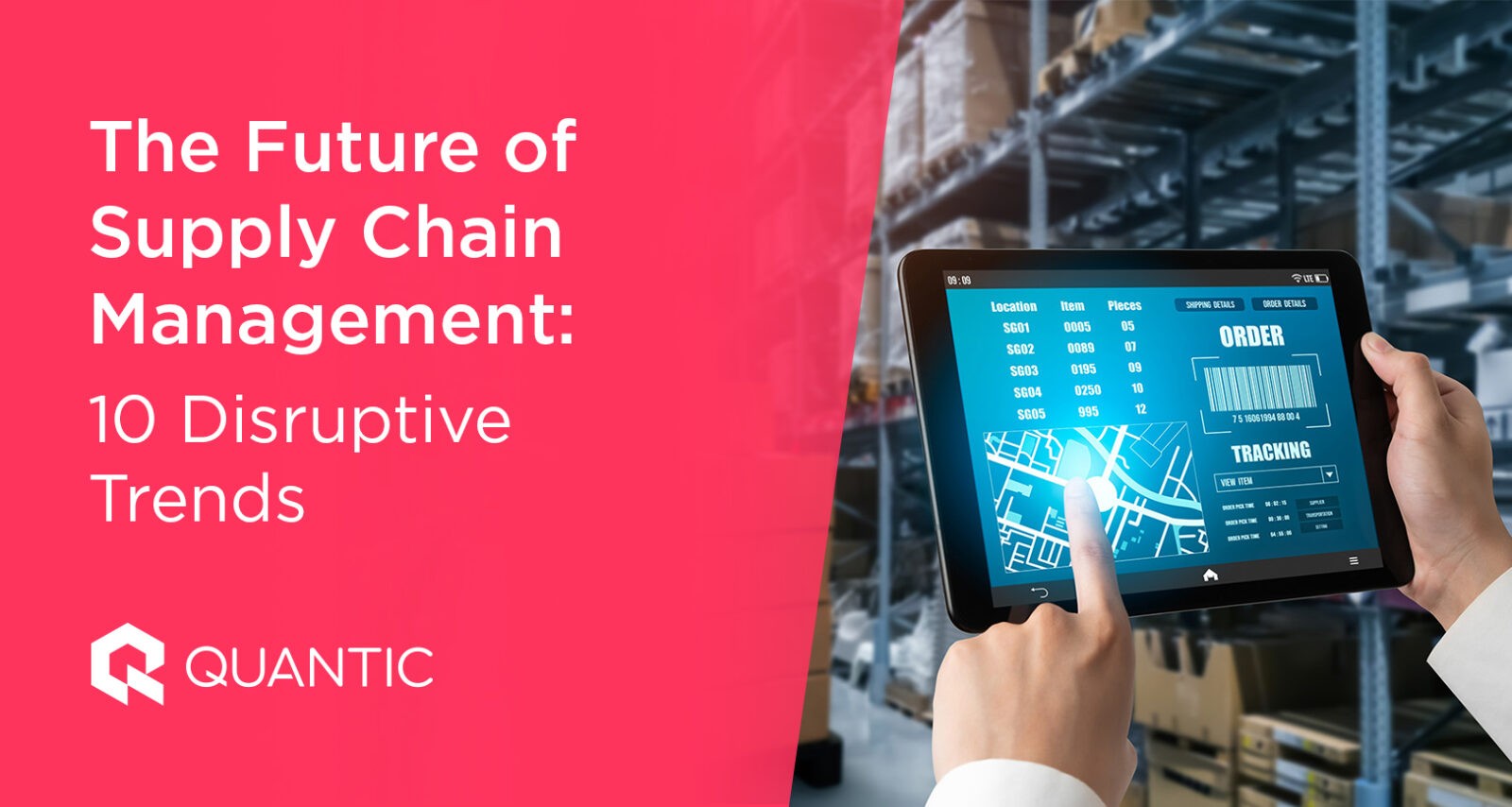MANAGEMENT
The Future of Supply Chain Management: 10 Disruptive Trends
Recently, globalization took a step backwards with border closures, delayed shipping, and slowed business activity.
As such, managers are now questioning the future of supply chain management after Covid 19: “Are there more upsets coming?” “Are businesses well-prepared?” “What will happen to supply management jobs?”
Well, here are 10 disruptive trends that are already influencing business:
- Blockchain
- Automated warehouse management systems
- Artificial intelligence
- eProcurement
- Big data
- Virtual reality
- Robotics
- 3D Printing
- Drones
- Sustainability
Today, we’ll delve into each trend’s impact on supply chains and how companies are preparing. We’ll also look at the future of supply chain management jobs and how other managers are adapting.
10 Future Trends of Supply Chain Management
Trend 1 – Blockchain
Alt: blockchain-powered Bitcoins
Initially, blockchain’s application in supply chain management was to secure financial transactions. Since then, it’s been extended to contracts.
Contracts in supply chain management often involve multiple parties and different jurisdictions; from the raw materials supplier to the manufacturer to the retailer. This makes information flow critical for operational efficiency and creates an opportunity for blockchain smart contracts.
Smart contracts work through a network of computers that automatically execute contract actions when pre-agreed conditions have been met and verified, such as:
- Releasing funds to relevant parties
- Registering the sourced material or ingredients
- Issuing a certificate or a ticket
- Generating signatures
This speeds up the supply chain by reducing the number of point-to-point communications needed between contracted parties, thus eliminating the need for third-party intermediaries.
In turn, faster processing reduces risks and lowers insurance premiums—explaining why more organizations are implementing blockchain technology in their operations:
- IBM and Maersk are jointly developing a contract collaboration platform using blockchain to reduce the 200 communications needed to ship one container of flowers from Kenya to Rotterdam.
- Driscoll’s, Dole, Tyson, and Nestlé are working with IBM to create a blockchain system for the food supply chain.
As organizations seek to improve their supply chains’ efficiency, blockchain will expand to industries other than logistics and manufacturing.
For instance, real estate transactions have lots of paperwork that require agents to verify and transact. Blockchain simplifies this process by tokenizing real estate assets, providing irrefutable proof of ownership and facilitates transactions without expensive paperwork and go-between agents.
Increased blockchain use will create more career opportunities while redefining traditional roles. Professionals will, therefore, need a fundamental understanding of blockchain, which is available through modern MBA programs, such as Quantic.
Quantic Business School offers a comprehensive course on blockchain that educate you on:
- The key elements of a blockchain and how the consensus mechanism works
- How blockchain compares to traditional third-party models
- How cryptocurrencies implement blockchain technology
Trend 2 – Automated Warehouse Management Systems
The traditional role of warehouses as mere storage facilities has been changing over the years. Their emerging role in supply chain management includes value-adding logistics activities that improve productivity, such as cross-docking, just-in-time delivery, and reverse logistics.
This added complexity has resulted in greater use of automated management systems, including:
- Automatic storage and retrieval systems
- Automatic sorting systems
- Computerized stock replenishment
Such systems facilitate the movement of goods throughout the warehouse while preventing stock shortages and reducing order cycle time. Their effectiveness Is why they’re becoming increasingly popular among organizations, as in the cases below:
- Nike increased its throughput from 100,000 to 250,000 units per eight-hour shift and reached an order accuracy of 99.8% with automated systems.
- Kimberly-Clark reduced labor costs by 10% by replacing manual stock locating systems with automated ones.
- Nestle implemented automated systems in its storage facilities and maximized efficiency across the entire distribution operation at its central finished goods depot.
As technology continues to develop, more organizations will incorporate automated management systems into their supply chains.
A recent study predicted a 4%–5% annual growth rate for the US market and that the future of supply chain management software will be in storage, inventory adjustment, and cycle counting.
Trend 3 – Artificial Intelligence
Pricing your goods or services is an old problem with a new solution: artificial intelligence (AI).
AI has refined modern pricing strategies by accurately predicting consumer behavior towards price changes and recommending the most optimal ranges.
This information is especially useful when launching new products or dealing with limited edition items (as is common in the fashion industry). In each case, wrong pricing costs profits and your reputation, which is quantified as future lost sales.
To avoid this, AI algorithms weigh micro and macro factors, such as competition, margin objectives, and inventory, to find optimal price ranges. This strategy’s success can be seen in the examples below.
- Pharmapacks, a health and wellness brand, used a pricing software called MasterMind to increase sales by six times. By 2016, their sales revenue had risen to $160 million.
- Rue La La, an online fashion shop, developed an AI algorithm that generates the best prices for next-day sales items. The model increased revenue by 10% within the first year of implementation.
In an increasingly connected world with abundant computing power, AI systems will have more data to work with and ability to process it. This will improve effectiveness and extend AI’s role in areas such as outbound logistics.
For instance, Amazon just released Scout, an AI-powered robot to deliver goods to their customers.
Trend 4 – eProcurement
Companies have realized the importance of procurement in the supply chain. A recent study at Mercedes discovered that a 10% increase in turnover was the equivalent of a 0.5% decrease in material costs due to the leverage effect of procurement costs.
This realization has led to the rapid adoption of eProcurement systems as a means of improving efficiency—they facilitate greater collaboration between suppliers and customers through internet portals.
For instance, in the auto industry, manufacturers report their demand and inventory status through supplier portals. Suppliers then feed the supply chain according to this real-time data. This collaboration speeds up the supply chain and eliminates waste through excessive stock.
Current research focuses on incorporating mobile technology into existing eProcurement solutions.
Mobile devices enable administrative functions, such as creating and approving purchase requisitions, outside of the office. This ability speeds up management since workers fulfill their roles regardless of location.
Trend 5 – Big Data
Today’s supply chains generate data at a rate that doubles in volume every two years—due to the widespread deployment of autonomous management systems, connected devices, and sensor networks across entire global chains.
The constant stream of data has greatly expanded the scope of analytics and improved decision-making.
For instance, IBM recently used big data to establish links between weather forecasts and production planning for bakeries. By integrating temperature and sunshine data, IBM helped baking companies predict demand for various product categories.
Meanwhile, Amazon recently patented its anticipatory shipping approach, where goods are placed into the delivery networks before customers actually order them.
As these examples demonstrate, the world’s reliance on big data is increasing, creating massive career opportunities for specialists. Already, firms are creating new roles, such as predictive risk management and clean sheet modeling.
These new frontiers are part of a coming wave and excellent reasons to start a course in data science today.
Explore big data and more with Quantic’s online EMBA that’s designed to suit the needs of a working professional. The program is highly flexible to incorporate work schedules—learners only need to commit to a minimum of five hours each week.
Trend 6 – Virtual Reality
Virtual reality (VR) is improving efficiency in supply chains across various industries.
For instance, in the automotive industry, VR is allowing engineers and designers to tinker with the look and build of a vehicle before commissioning expensive prototypes.
In education, virtual reality is boosting knowledge retention rates through experienced-based learning while limiting costs since the training is digital. Companies such as TransfVR are emerging with training models delivered entirely through digital simulations.
This trend will continue with VR extending toward the customer end of the supply chain. Already, the fashion industry is using the technology to enable product sampling. Meanwhile, in the auto industry, dealers are using VR to boost sales through virtual showrooms.
Trend 7 – Robotics
The International Federation of Robotics reports that there is a new record of approximately 3.5 million operational robots worldwide, with an estimated installation value of 15.7 billion USD in 2023.
This growth is largely driven by the automotive sector which is why robot density is specifically high in countries with strong auto industries. The following table compares robot densities in various countries with their auto production.
| Country | Robot Density (2019) | Vehicles Produced (2019) |
| China | 783,000 | 11,167,000 |
| Japan | 355,000 | 8,326,000 |
| USA | 293,000 | 2,512,000 |
| Germany | 221,000 | 4,664,000 |
| Italy | 74,000 | 542,000 |
Source: World Robotics Report and Bureau of Transportation Statistics
As the table highlights, China, the leading automobile manufacturer, also has the highest robot density with 783,000 units as of 2019. Japan comes in second with 355,000 factory robots and is also a major automaker.
This trend will continue with robots playing a larger global role in industries such as warehousing and retail. Popular examples are warehousing robots, such as Kiva, and Amazon’s delivery robots, such as Scout.
Trend 8 – 3D Printing
The future of supply chain management after Covid 19 demands shorter sourcing and 3D printing is emerging as an excellent solution.
In the Netherlands, several trains with 3D printed parts are now in operation. Meanwhile, Deutsche Bahn, the German railway company, recently printed 15,000 spare parts for its entire fleet of over 1,000 locomotives.
Using 3D printed has cut the weeks-long wait—recently exacerbated by Covid—to just a few hours of printing and fitting. This has also reduced the need for inventory space since the parts are printed on a needs basis.
Equipment manufacturers are also realizing more efficiency with 3D printing. Recently, Xerox printed a bracket for their 15-year-old digital press whose supplier had ceased production. The printed bracket was 21% cheaper with 43% fewer emissions.
In the future, 3D printing will move beyond producing spares to greater manufacturing. Already, an Italian start-up, XEV, is developing 3D-printed electric cars for mass production.
Trend 9 – Drones
In recent years, drones have become an important part of supply chain management, mostly for asset monitoring and transportation. This is because they’re more cost-efficient and effective than traditional solutions.
For instance, powerline inspections were initially conducted using a helicopter, two pilots, a cameraman, and an assistant. Now, all it takes is a camera-fitted drone and a wireless connection.
In 2014, DHL successfully used drones to deliver medicine to Juist, an island off the coast of northwest Germany. The flight lasted 30 minutes and put paid to traditional ferry and flight delivery methods—it was the start of a more effective, cheaper service.
Going forward, drones will play a greater role in logistics through last-mile deliveries of small packages. They will be a faster option for current routes and an extension of services to hard-to-reach locations.
A recent study by the National Aeronautical Center found that 42% of logistics carriers plan to use drones in the future.
Trend 10 – Sustainability
Organizations are becoming increasingly mindful of the environmental impact of their operations. This has led to the rise of concepts like closed-loop supply chains and reverse logistics.
They are based on the idea that supply chains don’t end at sales points, and can include after-sales operations, such as recycling and reusing. For instance:
- Walkers recently launched its recycling scheme where collected packets were recycled into outdoor furniture.
- Nike launched collection points for old shoes, which were then processed into raw materials for new ones.
As this trend progresses, companies will step up sustainability practices throughout their entire supply chain. Already, companies, such as General Mills, have promised to cut emissions from farm to landfill by 28% within 10 years.
Future Challenges of Supply Chain Management
Raw Material Shortages
While globalization has created efficiency through outsourcing, it has also resulted in an overreliance on distant sourcing. Companies are now more vulnerable to disruptions and likely to face future raw material shortages.
Recently, Tesla announced that its supply chain was its main limit to growth and is expecting a 50% growth for 2022. This is due to the current global shortage of microchips that’s persisted for over a year.
Organizations need to diversify their sourcing with local suppliers to limit their exposure to sudden shortages and ensure continued operations. This is why Tesla switched to more available microchips and quickly rewrote its code to avoid slowing production and prevent future shortages.
Redundancies
Massive layoffs are huge reputational risks for companies, yet inevitable with technological advancements. For instance, warehouses initially required workers to carry inventory which later changed to forklifts and is now leaning towards automated machinery.
As a result, organizations must invest more in employee upskilling to limit the impact of optimization and technological adoption.
The good news is that there are comprehensive learning platforms, such as Quantic, that feature active learning methods for maximum knowledge retention. The program is fully online and part of the emerging trend after Covid.
Future of Supply Chain Management Jobs
Initially, the major focus of supply chain managers was production costs. Performance measurement, meanwhile, was based on:
- Unit manufacturing costs
- Labor productivity
- Machine utilization
- Output
Today, it’s not enough for the manager to know who the best raw material supplier is and the best processing practices. They also need a better understanding of the end users’ needs and their buying patterns to inform the entire supply chain.
This is why more supply chain managers are undertaking business courses such as Quantic MBA. The program offers five courses on supply chain management that educate learners on demand uncertainty and the fundamentals of forecasting.
Apply for the Quantic MBA Program today and stay ahead of the curve.
“Participating in Quantic’s EMBA influenced how I approached my current role and contributed to me receiving a promotion.”
Marcus Gilmore, Sr. Manager, Center for Sustainable Energy



